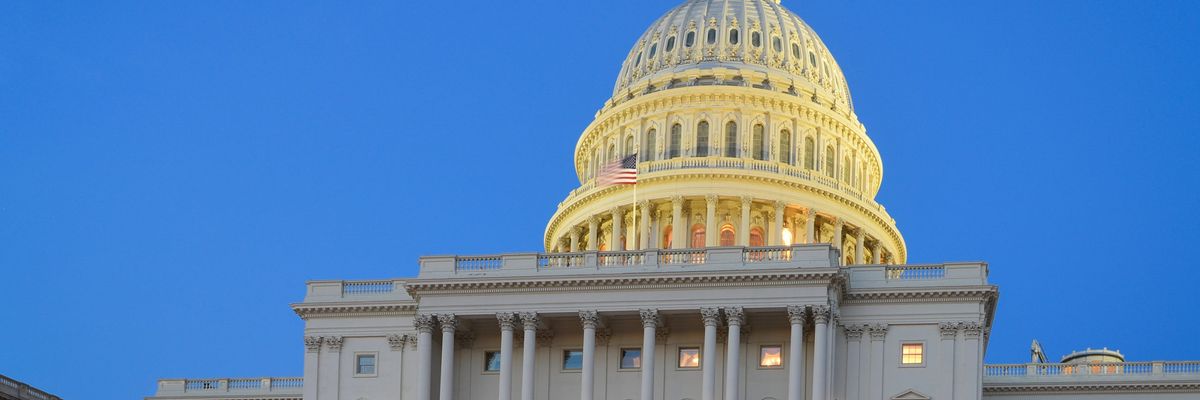Reporters, lobbyists, activists, Biden administration officials and, of course, lawmakers and their staffs spent countless hours and an ocean of ink on the negotiations for and passage of a recent bipartisan infrastructure bill totaling around $1 trillion. Casual observers probably won’t hear as much, though, about two votes — one in the Senate and one in the House — that could pave the way for Congress to spend a whopping $1.2 trillion additional dollars on the military, above current projections, over the next decades. Here’s how.
These pages recently covered the Senate Armed Services Committee’s successful effort to add $25 billion in taxpayer-funded slush to the annual defense budget bill. Democrats and Republicans joined hands to fatten up the defense bill by 3.5 percent, with Sen. Elizabeth Warren (D-MA) casting the lone dissenting vote. That increase was just endorsed by the House Armed Services Committee (HASC) on Wednesday.
Lawmakers approved, again on a widespread and bipartisan basis, an amendment by the committee’s ranking Republican, Mike Rogers of Alabama, to add $23.9 billion to the House version of the defense bill. Rogers proudly noted that his amendment would provide for a five-percent increase over the defense budget topline enacted in the previous fiscal year. And that’s where the $1.2 trillion comes in.
Defense hawks in Congress have made no secret that they would like to see up to 5 percent growth in the defense budget each and every year. Rogers has said it. His Senate counterpart, Jim Inhofe (R-OK), has also said it. What few budget or military watchdogs have done is explain the compounding effects of 5 percent annual boosts to the defense budget.
Boosting the defense budget 5 percent each year over the next 10 fiscal years would leave the U.S. with a whopping $1.2 trillion defense budget by the end of the decade, heading into fiscal year (FY) 2031. Compare that 5 percent boost each year to what the nonpartisan Congressional Budget Office currently projects defense spending will be over the next 10 years (as of their most recent July 2021 estimate), and the delta (the difference between a 5 percent annual boost and current budget projections) over 10 years is astounding.
The difference is small in the upcoming fiscal year, FY 2022 -- $778 billion if defense hawks get their 5 percent boost, versus $763 billion projected by the CBO. But the differences compound over time, exceeding a $100-billion delta in four years (FY 2026) and a $200-billion delta in eight years (FY 2030). By the end of the decade, FY 2031, the difference between the defense hawks’ ideal budget and the CBO projection is $253 billion — almost as much as was spent on the March 2020 $1,200 stimulus checks, to cite just one comparison.
Add it up over 10 years, and the defense hawks would have us spend $1,244,600,390,000 — that’s more than $1.2 trillion — more on defense than current projections. Unfortunately, the bipartisan votes in the Senate and House for a 5 percent defense budget increase in FY 2022 made this chilling possibility much more realistic.
It would be one thing if the defense hawks were proposing robust spending cuts — or tax increases, if that’s a particular lawmaker’s fancy -— to offset this additional $1.2 trillion in spending. But they are not. Rogers made no attempt to pay for his proposed $25 billion boost, nor did Senate Republicans who introduced their amendment on the Senate committee. And Democrats share plenty of the blame for eagerly supporting these amendments and allowing them to pass with wide bipartisan margins.
There are a number of ways to look at this $1.2-trillion budget-busting boost, depending on one’s political persuasions and policy preferences. Fiscal hawks will see another $1.2 trillion added to the record-high debt and deficit levels, high even by the COVID era’s historic standards. Progressives will argue that this $1.2 trillion could be spent on more pressing challenges like climate change and pandemic response. Regardless of where advocates and activists come down, this much is clear: a $1.2-trillion hike to the defense budget, without any corresponding offsets, comes at a significant cost to taxpayers.
It would be another thing if Rogers’ $23.9-billion push was devoted to urgent, emergency needs in the military. But in fact, billions of dollars are going toward the procurement of new ships, warplanes, and other weaponry that there is a questionable urgency for. Nearly a quarter of a billion dollars will go to the highly-troubled F-35 program. More than $3.6 billion will earmarked for just four new warships for the Navy, whose shipyards are already overburdened and underperforming, while another $567 million is directed toward requiring the Navy to accelerate its production of Virginia-class submarines (whose program, by the way, has suffered from cost overruns and delays). More than $6.5 billion will be spread around on military construction projects across 14 states, the District of Columbia, and Poland. Maryland (16 projects earmarked), Florida (12), and New Mexico (11) appear to be winners.
And, like Santa Claus on Christmas Eve, another $3 billion in the Rogers amendment will go toward fulfilling 69 “wish list” requests from the service branches and combatant commands. Fiscal and military watchdogs have sharply criticized this practice, warning that lawmakers will abuse these annual “wish lists” and gum up the defense budget -- which is exactly what the House and Senate committees have done.
A skeptic could claim that it’s “just” $25 billion this year, a drop in the bucket compared to the government’s trillions of dollars in COVID spending. But if the defense hawks get what they want, it will add up to $1.2 trillion over the next decade alone. That may not get the flashy headlines of an infrastructure bill, but it’ll have an even bigger impact on taxpayers’ pocketbooks.
















